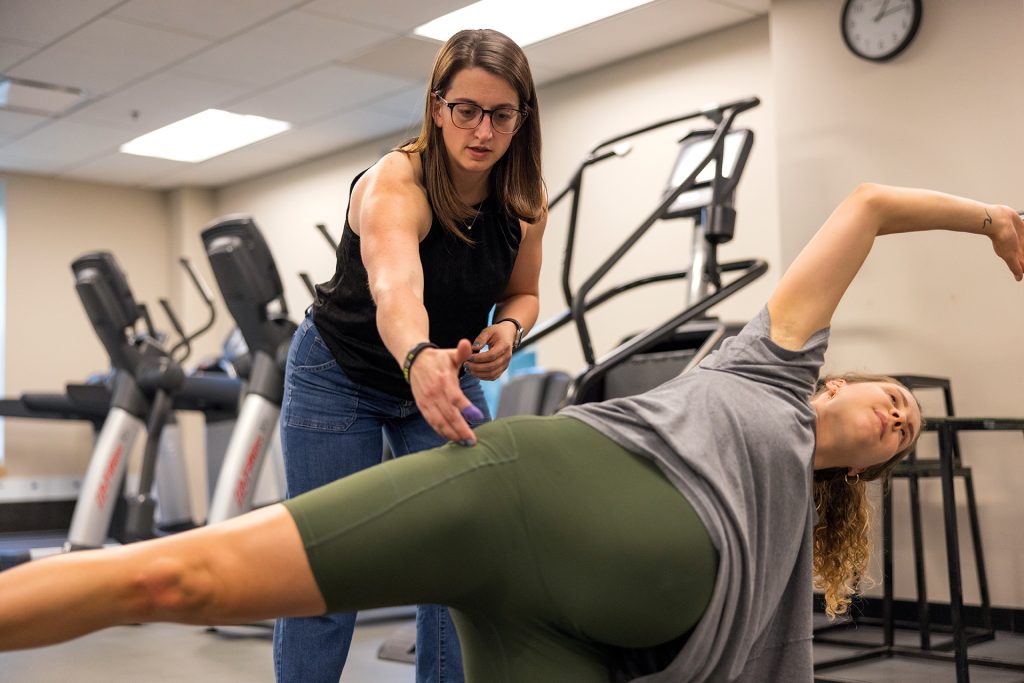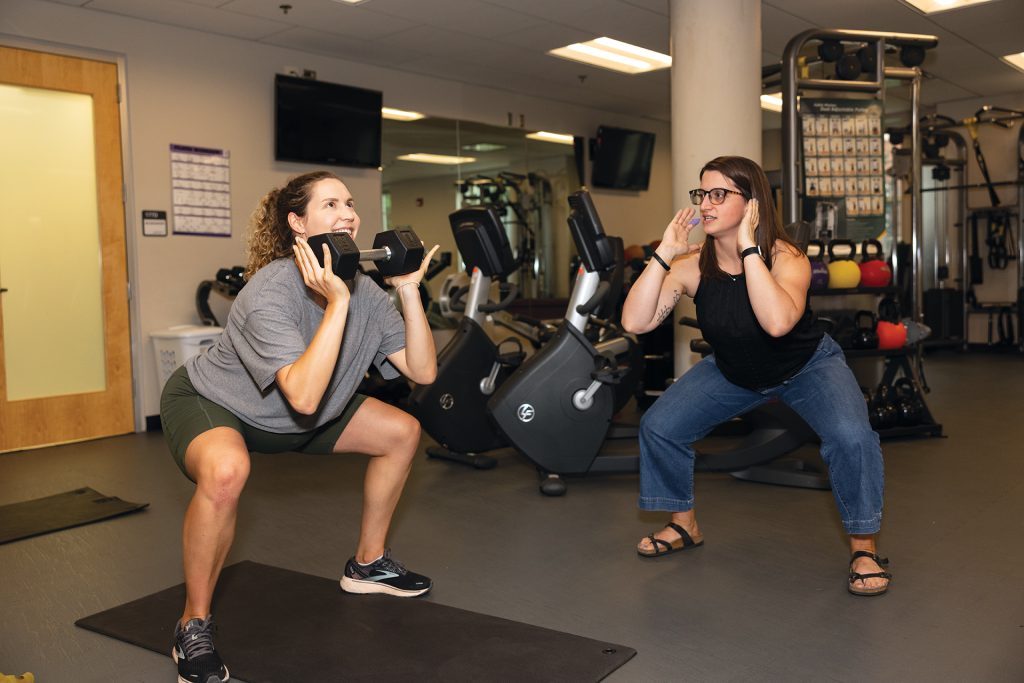The research of Dr. Samantha McDonald, assistant professor in the School of Kinesiology and Recreation, is big news for little ones. “If you are obese, your baby is born healthy if you exercise during pregnancy. You can break the cycle of obesity, positively impacting future generations,” said McDonald.
McDonald studies the effects of exercise during pregnancy, focusing on the metabolism. Metabolism is the body’s ability to manage glucose, sugars, and fats.
“There is a strong association with metabolism and chronic disease. If the mom supplies too much food to the baby, the baby can be born fatter,” McDonald said.
“Dysfunction in metabolism (like high levels of glucose and fats) are shown to be underlying risk factors for chronic disease,” McDonald explained. “Glucose is really toxic to the human body. We see so many neuropathies with Type 2 diabetes. It disrupts cellular function, weakens walls of the arteries, induces inflammation, and more.”
“This is why it is so critical to exercise,” she said. “We can account for up to 80% of glucose uptake in the skeletal muscle when we exercise.”
McDonald’s research initially started with a focus on children and chronic obesity. Then, she and a colleague started to explore increasing birth rates around the world, which led her to wonder what happens during pregnancy.
“There is a lot of accumulated evidence to suggest that obesity can be programmed in utero,” McDonald explained. “Glucose is the strongest predictor of fetal growth; babies must have glucose to grow during pregnancy. In areas of famine, you see babies born smaller. When mothers have diabetes, whether Type 2 or gestational, babies will be born bigger.”
“Exercise is the most potent thing you can do to impact metabolism,” she said. “Muscle accounts for where your energy goes. The more we exercise, the more we can control where our glucose goes.”
“We essentially control whether it will go into the skeletal muscle or to fat tissue,” McDonald explained. “Energy goes where it is needed. When we exercise, skeletal muscle energy stores need to be replenished. When the skeletal muscles need energy, less energy goes to fat tissue, which will consume energy without regulation.”
Babies born to moms who have exercised are leaner. “If they are born with less fat tissue, they have reduced risk of obesity and chronic disease. If a baby is born heavy, it’s harder for them to move,” said McDonald. “Heavier babies tend to have a delayed onset of motor skills because they have difficulty moving.”
“Babies are unbelievably resilient. Babies of mothers who have exercised in pregnancy have shown improved cardiac function. When we measure the neurological motor skills at one month of age—the moms that exercised had daughters that matched boys’ skill levels, meaning they were very advanced, which is not typical,” said McDonald.
There are still some misconceptions out there when it comes to exercise during pregnancy, and McDonald believes this is due to a lack of education. “We’ve come so far with educating expectant mothers regarding breastfeeding; I would like to see the same thing happen for exercise.”
One hundred fifty minutes a week is the standard guideline of moderate intensity activity (an example would be brisk walking). However, McDonald cautions that the guideline is not one size fits all. “That dose might not be enough for all expectant mothers. If you are overweight or obese, you have more of everything in your blood, so you need to do more activity to make an impact.”
McDonald acknowledges that light intensity exercise is better than nothing, but really encourages expectant mothers to get to the moderate level. In addition, she notes that some moms can continue exercising vigorously, if that is something they were used to before pregnancy. This would be in intermittent doses of exercise, not sustained, and an adequate food supply would be necessary. “Babies can be born fatter if women decrease their exercise throughout their pregnancy, so we really want to encourage them to keep moving.”
McDonald’s current study, her first as principal investigator (PI), measures exercise intensity using METs, a unit of measurement for the amount of oxygen that an individual breathes in, both at rest and while exercising. Pregnant women increase the amount of oxygen they burn at rest from the first trimester to the third.
“My study is trying to find the best way to measure intensity to more safely and effectively design exercise programs for pregnant women,” McDonald said. “METs are commonly used by exercise specialists; however, this metric assumes every human expends the same amount of energy at rest, not accounting for age, sex, race, ethnicity, and, pertinent to my research, it does not account for pregnancy status.
“In all of these cases, resting energy expenditures differ—and differ greatly. This introduces error. The last thing we want to do is under-prescribe an exercise dose or over-prescribe an exercise dose.”
The expectant mothers in McDonald’s study are treated as individuals and receive training plans tailored to their specific abilities, interests, and needs. “We tailor their workouts to their fatigue levels,” she said. “Pregnancy can be very taxing on the body, and some days you might have more energy than others.”
A lot of McDonald’s subjects are interested in exercise and movement, but unsure of where to start. “They hear 150 minutes and want to know how to fill it,” she said. “We offer a variety of activity options and have even made accommodations for our participants to swim.”
One of McDonald’s top recommendations for expectant mothers is resistance training. “When your baby is born, you need as much strength as you can get,” she explained. “Posture and balance are so critical, especially for those moms that experience C-section deliveries. Movement is so much easier when you have focused on your strength. In addition, you are less fatigued when it is easier for you to move.”
Women don’t always know where to start when it comes to resistance training, which is where student trainers come in. “Our students offer training sessions from 6 a.m. to 6 p.m. Our clients absolutely love them,” said McDonald. The student trainers are undergraduates in their third or fourth year and one graduate student. “The students are initially a bit hesitant—it’s rare any of them have worked with pregnant clients before. They quickly realize pregnant women are incredibly resilient, and along with that, they are not afraid to tell you what they can and cannot do.”
McDonald’s team of student trainers is equipped to make the necessary modifications and make sure their clients find success throughout the pregnancy journey. “After a certain time, we won’t program exercises where they are laying on their back, and side lunges might start to feel better than forward lunges.”
The program benefits the exercise science students, in addition to the mothers. “These students have dedicated so much of their time to help. When they start applying to physical therapy and occupational therapy schools, they will be in the top 5% of candidates, due to this unique skill set they are building.”
The emphasis on movement for pregnant women is so great that McDonald’s study does not have a control group. “I can’t ethically tell someone to be part of my control group. I don’t want anyone to be doing nothing or only light activity during pregnancy. You are putting a woman at risk by telling her to stop exercising. Insulin resistance and glucose levels are lower in women that exercise. If they stop exercising, the glucose levels increase.”
Many clients that McDonald works with have the desire to exercise, but not necessarily the knowledge of what to do and how to do it. “They leave with a special set of skills that will serve them well after birth,” said McDonald. “Trying to implement a new habit or routine postpartum is so difficult, but if you have a routine in place, it’s easier to get back into the habit. We also make sure the women find a form of exercise they enjoy. It’s more likely to be sustainable if it’s something enjoyable.”
McDonald’s work isn’t over yet. Her next project will have her partnering with biomechanics to look at muscle activity and the potential skeletal muscle changes during pregnancy. “We know exercise is effective at controlling metabolism, but is there anything we can do to make it more impactful? I want to dive into the physiology of it.” Eventually, McDonald hopes to have a program in place where expectant mothers are immediately referred from their OBGYN.
“Don’t be afraid to exercise,” McDonald said. “You have a very strong influence on the health trajectory of you and your baby that will affect generations to come.”
Any changes to your fitness routine should be made in partnership with your medical provider. To learn more about being a participant in McDonald’s research, contact her at smmcdo4@ilstu.edu.



